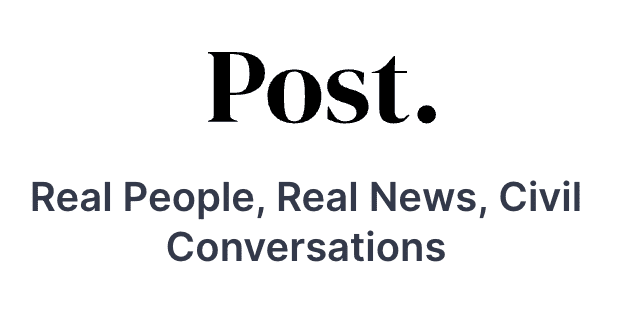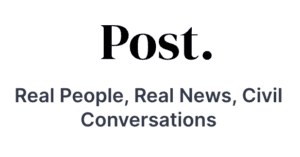
 With website business models that depend on clicks from social media platforms now broken, comes social news platform Post. Launched late last year with the goal of fostering civil discussion, Post was designed for premium publishers to meet and monetize new audiences on social media. Noam Bardin, CEO & Founder of Post, offers his thoughts on the future of news on social media platforms.
With website business models that depend on clicks from social media platforms now broken, comes social news platform Post. Launched late last year with the goal of fostering civil discussion, Post was designed for premium publishers to meet and monetize new audiences on social media. Noam Bardin, CEO & Founder of Post, offers his thoughts on the future of news on social media platforms.
You have said “social media has become the worst of us.” What do you mean by that?
Traditional social media platforms are toxic. Ad-supported algorithms, which are optimized for engagement, surface hateful content that generates anger, and keeps users spending more time on the platform. In essence, social media platforms actively accelerate the spread of misinformation, which we have seen in abundance with the ongoing conflict in Israel. This reinforcement of extreme viewpoints, on both ends of the spectrum, leads to more money in the pockets of platforms.
Instead of creating sophisticated means to moderate content, as our platform has from its inception, the dominating social media sites of today have embraced this sort of virulent environment in pursuit of profit. The lack of any sort of mechanism to extensively moderate content has nonetheless increased clicks and engagement on platforms, but at the cost of deteriorating societal values.
At the core of Post is the pursuit of being a force for good, instead of maximizing revenue at the expense of public discourse. The business models of today’s social media platforms are actively embracing “the worst of us.”
How does Post differ for users from other platforms?
When one of your friends or colleagues shares a news article on X that is locked behind a paywall, you are typically discouraged from purchasing a subscription to view one, singular piece of content. Post offers users the opportunity to consume that individual article for a sliver of what they would normally pay for a full subscription. Usually only costing a few cents, users are much more likely to pay for a piece of content when they otherwise would not have purchased a subscription to read an individual article.
A seamless user experience is top of mind on Post as other platforms’ news sharing services users often hit subscription paywalls and/or endless ads, resulting in a poor experience. On ours, users never have to leave the platform to view their favorite content. The news consumption process all happens within Post itself. When users sign up, they receive 50 free ‘points’ that they can use to unlock content directly in their feed, tip creators/publishers, allowing them to directly support independent journalism and creators in the process. Users have the option to refill via payment. The entire experience ensures content consumers are never interrupted by pesky paywalls and ads.
As our user experience is categorically different from other platforms, we also view success through a different lens. By employing a micropayment model, our algorithm is not focused on maximizing engagement and keeping users on the platform, sending them into an endless doom scroll to optimize ad revenue. Instead, our platform is designed to deliver high quality content to users. If a user leaves after reading one article and feels smarter, or more informed, Post has achieved its purpose.
What is the attraction for publishers?
At the core of Post, is the emphasis to increase monetization opportunities and attract new readership for publishers. For too long, news organizations have received the short end of the stick when it comes to monetizing their content. X’s recent move to remove links should be seen as indicative of how social media sites as a whole view news. Over the course of the year, Meta has decided to remove news from EU and Canada markets, and has stated they do not want news to be on Threads. This is all not a coincidence. Links to news sites take users away from platforms, where social media sites cannot advertise. Factor in that 20% of Americans subscribe to any news source, and only 10% to more than one, along with a recent report indicating that redirects from X, Meta, and Google, have plummeted to historic lows, the business models of news organizations are effectively broken.
Our platform is specifically designed for premium publishers to meet and monetize new audiences on social media. By offering an entirely unique user experience, and allowing users to read news in a social feed, publishers can reach new audiences much more easily. An all-in-one social feed for news is particularly appealing to younger audiences, which publishers have failed to attract in recent years. By offering these audiences a unique user experience, our platform has enabled publishers and creators alike the ability to build direct relationships with consumers who are not current subscribers. To encourage quality, sound, journalistic content; reporters, publishers and content creators alike need to have some sort of stability to their business models. Post fills this gap.
Publishers and content creators have the ability to automatically ingest their content, or program it manually on Post. Once this content is ingested into the platform, publishers have free reign to determine the best way to monetize, and can set pricing and business models themselves. Publishers receive 100% of the micropayments users make to access content and send tips. We never stand in the way between publishers and users. Adding even more value, we have recently introduced a suite of Creator Tools which includes auto-ingestion and distribution of newsletters. At a time when news organizations are struggling to stay afloat, our platform offers a much needed revenue stream and new distribution channel where the interests of the platform and publisher are aligned.
What do you think the future holds for X/Twitter?
Twitter used to be one of the only platforms I used extensively, so it is disheartening to see the direction it has trended. However, what many people fail to realize is that Twitter had a lot of problems before X. I am in no way taking away from Elon’s responsibility regarding the trajectory he has put the platform on, but, fundamentally, Twitter was a source of misinformation, disinformation and toxicity, and their business model was never sustainable. Twitter is built for culture warriors, the type of people who want to argue for 5 hours a day. The reality is that 75% of Twitter users have never tweeted. I do not think that Elon’s move to implement a subscription model will really change the platform’s trajectory. What we will see over the coming years is new social media companies pop up, taking away specific use cases from Twitter, and building platforms around them.







